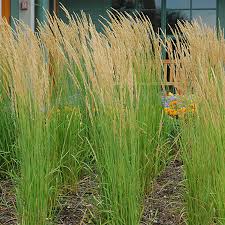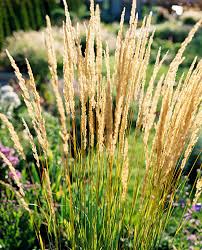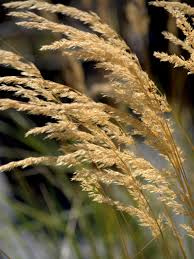Reed Grass, scientifically known as Phragmites australis, is a tall plant that grows in wetlands and along the edges of water bodies like lakes, rivers, and ponds. It’s an important part of many ecosystems because it provides shelter and food for various animals and insects.
This type of grass has long, sturdy stems that can reach great heights, often towering over other plants in the area. Its leaves are long and narrow, and they rustle gently in the wind, creating a soothing sound. The plume-like flowers of Reed Grass appear in late summer and fall, adding a touch of beauty to the landscape.
One of the remarkable things about Reed Grass is its ability to thrive in wet and marshy environments. Its roots help stabilize the soil and prevent erosion, which is important for maintaining the health of the ecosystem. Additionally, the plant offers nesting places for birds and homes for insects, contributing to the overall biodiversity of the area.
People have found various uses for Reed Grass throughout history. Some cultures have used its stems to weave baskets, mats, and even roofs for shelters. Its seeds and young shoots are also edible and can be used as food sources. In some places, Reed Grass has been used for water purification, as its roots can help filter out impurities from the water.
However, it’s important to manage the growth of Reed Grass carefully. In some cases, it can become invasive and spread rapidly, outcompeting native plants and disrupting the balance of the ecosystem. Balancing the benefits of Reed Grass with the need to control its growth is a challenge that land managers and conservationists often face.
In addition, Reed Grass, or Phragmites australis, is a fascinating plant that plays a crucial role in wetland ecosystems. Its tall stems, swaying leaves, and plume-like flowers contribute to the beauty of natural landscapes while providing habitat and resources for various organisms. Understanding and managing its growth is essential to preserving the delicate balance of these ecosystems.
Read Also: All You Need To Know About Couch Grass (Elymus Repens)
Growing Guide of Reed Grass

Here’s a simple growing guide for Reed Grass:
Reed Grass, also known as Phragmites australis, can be a wonderful addition to your garden or landscape, especially if you have a wet or marshy area. Follow these steps to successfully grow Reed Grass:
1. Choosing the Right Location: Select a spot that receives plenty of sunlight. Reed Grass prefers full sun but can tolerate some shade. Make sure the area has access to water, as this plant thrives in moist or wet conditions.
2. Preparing the Soil: Reed Grass is adaptable to various soil types, but it prefers soil that is moist and well-draining. If your soil is heavy and clay-like, consider adding organic matter like compost to improve drainage.
3. Planting: Plant Reed Grass in the spring or fall. Dig a hole that’s slightly larger than the root ball of the plant. Place the plant in the hole at the same depth it was in the container. Fill the hole with soil and gently pat it down.
4. Watering: Keep the soil consistently moist, especially during the plant’s early stages of growth. Water deeply and regularly to help the roots establish themselves. Once the plant is established, it will be more tolerant of drier conditions.
5. Mulching: Apply a layer of mulch around the base of the plant to help retain moisture and suppress weeds. This is particularly important during the first growing season.
6. Pruning and Maintenance: In late winter or early spring, cut back the dead stems to about 6-12 inches above the ground. This will encourage new growth in the upcoming season. Be careful not to cut too low, as Reed Grass needs some of the older growth for support.
7. Managing Growth: Reed Grass has a tendency to spread aggressively in some regions. If you’re concerned about it becoming invasive, consider planting it in a container or using a root barrier to control its growth.
8. Pest and Disease Control: Reed Grass is generally resistant to pests and diseases. However, keeping the area around the plant clean and free of debris can help prevent any potential issues.
9. Wildlife Benefits: Reed Grass provides habitat and food for various birds and insects. Consider leaving some of the dried stems standing over winter to provide shelter for wildlife.
10. Division: Over time, Reed Grass can become crowded. To rejuvenate the plant, consider dividing it every few years in the spring. Dig up the plant and separate the clumps, then replant the smaller divisions.
By following these simple steps, you can enjoy the beauty and benefits of Reed Grass in your garden or landscape. Remember to tailor your care routine to the specific conditions of your location and keep an eye on the plant’s growth to ensure its health and vitality.
Caring Guide of Reed Grass

Here’s a caring guide to help you maintain healthy and thriving Reed Grass (Phragmites australis):
Reed Grass, with its graceful appearance and ecological benefits, can thrive with proper care. Follow these care tips to ensure your Reed Grass remains healthy and vibrant:
1. Watering: Reed Grass prefers consistently moist soil. Water deeply and regularly, especially during its growing season, which is typically from spring to fall. However, avoid waterlogging the soil, as Reed Grass doesn’t tolerate standing water for extended periods.
2. Mulching: Apply a layer of organic mulch around the base of the plant. This helps retain soil moisture, suppress weed growth, and maintain an even temperature around the roots.
3. Fertilizing: Reed Grass generally doesn’t require frequent fertilization. If your soil is nutrient-poor, you can apply a balanced, slow-release fertilizer in the spring. Be cautious not to over-fertilize, as this can lead to excessive growth.
4. Pruning: In late winter or early spring, trim back the dead stems to a height of about 6-12 inches from the ground. This rejuvenates the plant and encourages new growth in the coming season. Removing old growth also prevents the plant from becoming too dense.
5. Division: Every few years, consider dividing the plant in early spring to prevent overcrowding. Dig up the clump and separate it into smaller sections, each with roots and shoots. Replant the divisions, ensuring they have enough space to grow.
6. Pest and Disease Management: Reed Grass is generally resistant to pests and diseases. However, keep an eye out for aphids, leafhoppers, or fungal issues during periods of high humidity. Regularly inspect the plant for any signs of distress and take appropriate action if needed.
7. Wildlife Considerations: Allowing some of the dried stems to remain over winter can provide shelter and nesting sites for birds and insects. This enhances the ecological value of your Reed Grass.
8. Managing Invasiveness: If you’re concerned about Reed Grass becoming invasive, choose native varieties or cultivars that are less aggressive. Regularly monitor the growth and remove any unwanted shoots that may spread too rapidly.
9. Winter Care: In colder climates, Reed Grass can benefit from a layer of mulch around its base to protect the roots during winter. However, avoid covering the crown of the plant, as excessive moisture can lead to rot.
10. Naturalize Wisely: When planting Reed Grass near natural water bodies, ensure you’re using native species and following local regulations. Invasive varieties can outcompete native plants and disrupt local ecosystems.
By following these care guidelines, you can maintain a healthy and attractive Reed Grass in your garden or landscape. Remember that every location is unique, so pay attention to the specific needs of your plant and adjust your care routine accordingly.
Read Also: A Guide to Growing and Caring for Stipa Grass (Stipa)
Feather Reed Grass

Feather Reed Grass is a lovely plant known for its tall, feathery plumes that sway gracefully in the wind. Its scientific name is Calamagrostis x acutiflora. This type of grass is a popular choice in gardens and landscapes because of its elegant appearance and easy care.
Feather Reed Grass has slim leaves that grow upright, and in the summer, it produces tall stems with soft, fluffy flowers on top. These flowers resemble feathery plumes, which is why it’s called “Feather” Reed Grass. The plant can add a touch of beauty and movement to gardens, especially when its plumes catch the sunlight.
This grass is adaptable and can grow in various soil types, but it prefers soil that is well-draining. It’s quite hardy and can tolerate both sunny and partially shaded areas. Feather Reed Grass doesn’t need a lot of water once it’s established, making it a low-maintenance choice for many gardeners.
One of the reasons people like Feather Reed Grass is its versatility. It can be used as a striking focal point in a garden or as a border plant to define different areas. Additionally, it attracts birds and insects, adding life to your outdoor space.
To care for Feather Reed Grass, trim back the old growth in late winter or early spring before new growth begins. This keeps the plant looking neat and encourages healthy growth. Dividing the plant every few years can help maintain its vigor.
In conclusion, Feather Reed Grass, scientifically known as Calamagrostis x acutiflora, is a charming and adaptable grass that brings beauty and movement to gardens. Its feathery plumes and low-maintenance nature make it a popular choice for both beginners and experienced gardeners alike.
